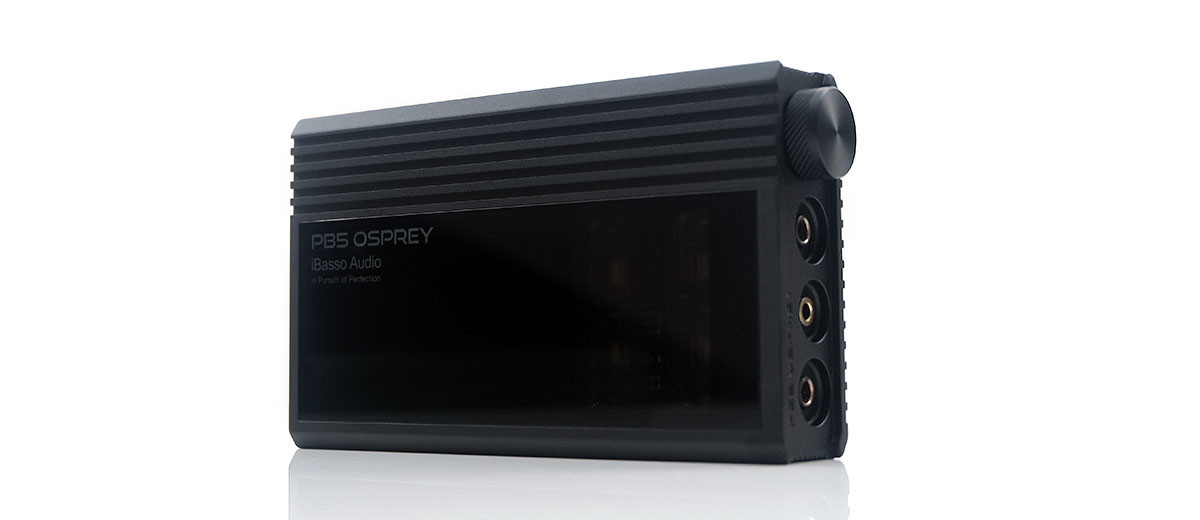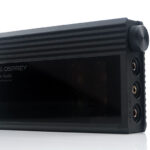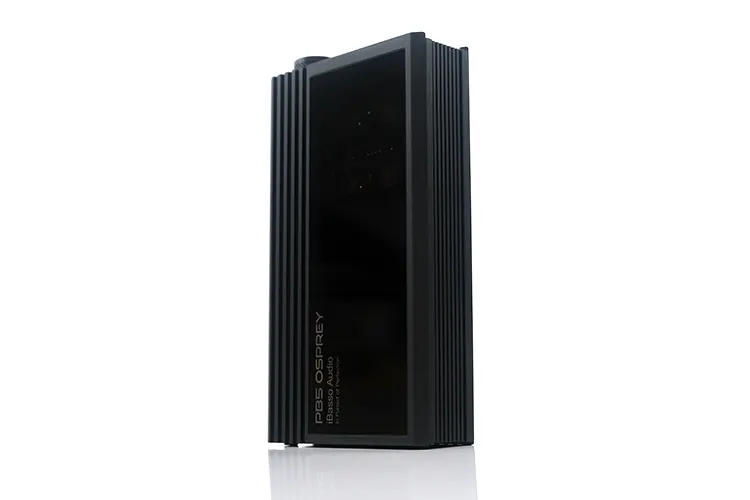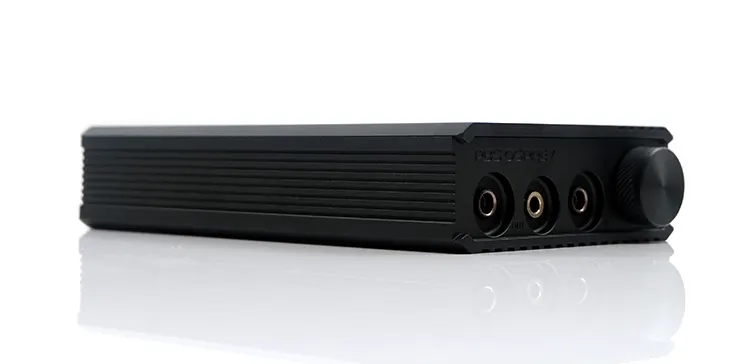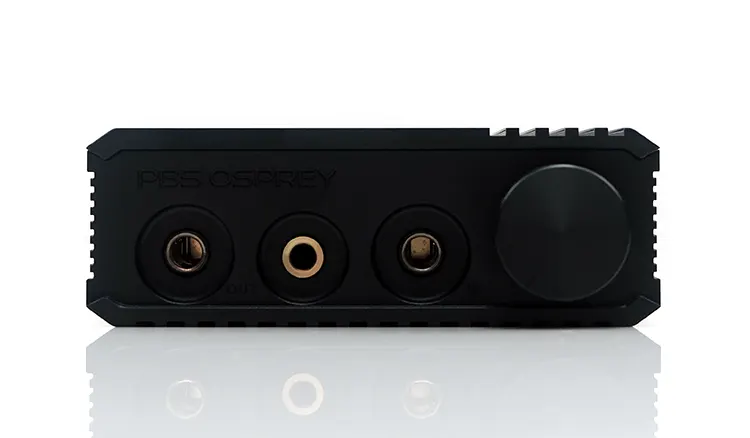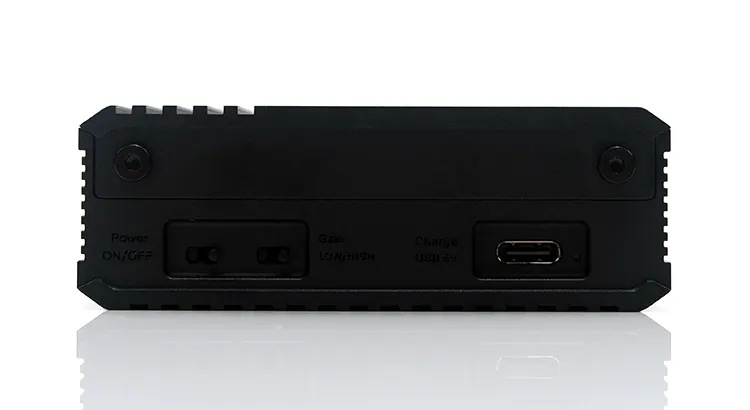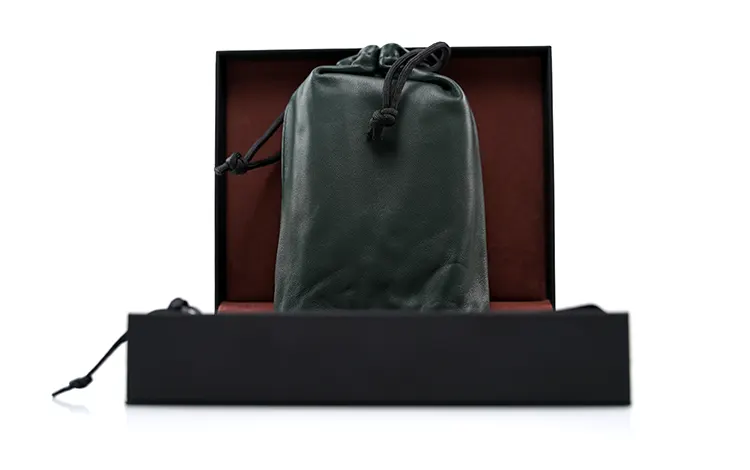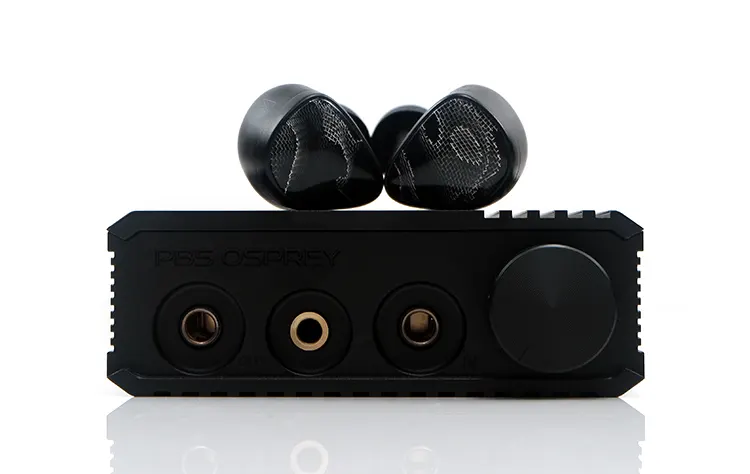Today, Marcus reviews the iBasso PB5 Osprey, a high-end dual Nutube 6P1 tube portable headphone amplifier with up to 1.7W of output power. It is priced at $1499.
Disclaimer: I received this sample in exchange for my honest opinion. Headfonics is an independent website with no affiliate links or status. I thank iBasso for this opportunity.
Click here to read more about iBasso products we have previously reviewed on Headfonics.
This article follows our current scoring guidelines, which you can read in more detail here.
The iBasso PB5 Osprey is part of a dual release earlier this year, the first of which we have already reviewed: a portable 1BIT DAC called the D16 Taipan.
Together, they form iBasso’s interpretation of a compact transportable ‘audiophile stack’, some ideal for offices and homes-based compact high-end systems. Throw in the DX320 MAX Ti, and you have a complete standalone battery-powered audio system for IEM and headphone users.
Since the D16 already has an integrated amplifier, not to mention the excellent design inside the DX320 MAX Ti, why add another? To keep the answer short, just two words—tubes and power.
These days, I rarely get a pure portable analog amplifier on my desk for review. It is even rarer to get a dual-tube version, especially when those tubes are Korg Nutube 6P1 versions with the Cayin C9 as the only alternative I have heard on the market today.
At $1499, the PB5 Osprey’s compact design, smooth tube sound signature, and excellent power handling seem to aim for the C9 crown as the best high-end portable tube-based amplifier in the market.
I have alternatives from Phatlab and I still fondly hold onto my ALO Audio Continental Dual Mono but aside from the soon-to-be-reviewed C9ii, the PB5 Osprey is well ahead of those noted alternatives.
Features
The PB5 Osprey is a balanced-designed portable vacuum tube headphone amplifier. It can be used as a standalone amplifier with a DAC and source of your choice or you can stack it neatly with the D16 decoder and the DX3XX series as a source.
The PB5 is voltage amplified by a set of modern anode grid filament Korg Nutube 6P1 tubes, similar to the ones used by Cayin inside their C9 amplifier and the N8ii DAP.
Combined with VCEsat dual transistor-based current amplification and an internal 6 x 900mAh (3 x 8.4V) battery supply, the PB5 Osprey has a rated maximum output voltage of 9Vrms (4.4mm) which is capable of up to 1700 mW output power under a 32Ω load.
To prevent microphonic pings and keep the 6P1 tubes as stable as possible, iBasso has also implemented a two-step suspension system to reduce the impact of sudden vibratory events including a cathode input to keep impedance-related resistance as low as possible.
Consistent with the D16 and first introduced with the DX320 MAX Ti, the PB5 Osprey also has iBasso’s 4-wiper stepped attenuator with 24 steps offering a claimed +/- 0.1dB of tolerance in-between each step.
Some love this, some do not but combined with the D16’s more granular digital volume control system it should provide an effective, clean sound with above-average channel balance for an analog potentiometer.
Design
The exterior of the PB5 is almost a carbon copy of the D16 Taipan. Primarily so they can stack neatly on top of each other and also to allow for the similarly sized DX3XXX MAX series to sit like a ‘cherry on top.
The matching design means my thoughts from the D16 are relatively unchanged for the PB5. Phrases such as “old-school boxy compact portable design” and “black ribbed aluminum housing” are consistent observations from each device given their outward appearance and identical form factor.
There are some differences though. For one, the PB5 is slightly heavier than the 312g D16 but not noticeably so at 352g. A weight difference likely to be rendered moot when sat on the table under or above the D16 and a MAX series DAP.
Also, instead of a top panel LCD, the PB5 Osprey has a transparent panel to allow you to see the tubes light up with a green glow during operation, perhaps a centerpiece attraction for many owners.
I/O
Charging, gain levels, and the power switch are on the rear panel, with the TRRS and TRS I/O housed on the front panel of the PB5 Osprey.
That includes options for a balanced and SE PO as well as a single 4.4mm balanced line-level input or LO. I suspect some might complain a little about the lack of 3.5mm line-level input, especially considering the D16 has a 3.5mm LO option.
The rear panel has two recessed panels housing power and low/high gain switches to the left and charging via USB-C to the right. There is a 9.5 dB swing between the low gain which is set at 2 dB and the high at 11.5 dB.
The PB5 Osprey’s six-battery array is designed to deliver up to just over 10 hours of playback time with charging around 2.5 hours. I presume the weighting on that measurement is based on a low gain medium volume setting with a 32Ω load.
At the back, you get a very small blue LED light that indicates charging via an intermittent blink and is steady when charged.
One caveat is the 5V charging parameter, which means PD charging is out. I tested the PB5 with my trusty PD2.0 charging setup and 65W charger plug and nothing happened.
As with the D16, the PB5 Osprey I/O layout is neat but the labeling is much too small for my eyes. Even with reading glasses and a torch, I had a challenging time reading the gain switch.
Along with the very faint volume marker, it makes the PB5 not the most user-friendly for legible labeling. I hope iBasso can switch this to white on any future iteration if they wish to retain the small, engraved sizing.
Packaging & Accessories
The PB5 Osprey packaging is also very similar to the D16, at least in materials choices and finishing of the box, pouch, and leather wrapper case.
That means a very soft faux leather display box with a nice rouge inner, combined with a dose of green from the soft leather pouch beside a slimline black suede accessory bag.
Since this is an analog amplifier, the accessories are different from what comes with the D16 Taipan.
Inside that slimline bag you get a USB-C to USB-A charging cable plus two 4.4m braided high purity SPC wire interconnects with some of the beefiest and most unique barrels I have ever seen.
They look awesome from a design perspective and really stand out from slimline alternatives. They also fit the PB5 ports perfectly but I will say people might struggle with the barrel diameter if they want to use them on smaller amplifiers with limited plug spacing.
The cables also come in different lengths with a 3.5″ version ideally for stacking with the D16 to keep cable untidiness at bay. The second is a longer 12″ version to give you some additional flexibility in placement.
Sound Impressions
The sound impressions of the iBasso PB5 Osprey were completed using the iBasso D16 Taipan and DX320 MAX Ti as source and decoder with a mix of Noble Audio’s Onyx, the Vision Ears VE10 and the ZMF Headphones Caldera for matching headgear.
Summary
The PB5 Osprey tuning is an elegant combination of power, dynamic range, and enticing vacuum tube smoothness.
However, this is not a classic relaxed tube sound, at least not with my tested gear. It has energy, some weight in the lows, and a nice punchy character. There is nothing passive about the PB5’s performance.
It is not as weighty on the sub-bass as something like the C9. However, the PB5 Osprey makes up for it with an enhanced body through the mid-bass and beyond producing a fleshier fuller tone, especially when compared with the DX320 MAX Ti’s cleaner, and more pristine presentation.
Its liquid highs can take a bit of edge off just about any IEM or headphones without dramatically altering their core sound signature.
Some might prefer the stronger treble extension that iBasso is known for in its DAP tuning. In the case of the Noble Audio Onyx’s darker tuning and, to a lesser extent, the Andromeda 2020, the brighter highs of the DX320 MAX Ti are an advantage.
However, if you are using gear such as the HEDD Audio HEDDphone Two, or the more neutral Empire Ears ESR MKII that is to your benefit because the sound is firm without ever sounding overly sharp, and still with excellent headroom.
And of course, the power gives it an edge over the D16 Taipan and the DX320 MAX Ti. Headphones such as the ZMF Headphones Caldera have this dynamic snap and additional staging depth that is more neutral and flatter sounding with those aforementioned units.
If there is a slight weakness to the PB5 performance is tube ping. However, it is more prevalent with sensitive IEMs on initial plug insertion with a quick dissipation thereafter. Background hiss in general is well under control.
Coloration
Fulsome and impactful sounding to put it succinctly. The PB5 Osprey creates a very fine balance between heft and natural warmth on one side and clarity and resolution on the other.
For example, coming from the DX320 MAX Ti, the coloration throughout is thicker sounding, with a slightly softer attack and longer decay combined with a smoother set of highs.
Compared to the C9, the midrange note timbre is more physical and saturated sounding but with less sub-bass weight and treble sparkle on either extreme.
I would argue if there was any tuning bias it’s from the bass to mids and that is generally where I heard the most influence on the tested gear and why the word “fleshy” is used in my initial description.
As a result, vocals are gorgeous on the PB5 using neutral IEMs which faithfully reproduce a rich analog texture without smear or sounding too rounded. That is an area I would use some caution at the same time.
The elevated mid-to-upper bass impact and warmer lower mids might not gel well with gear that is already significantly enhanced in this region. L-shaped monitors such as the Onyx can sound a little too dark with an overly-emphasized low end for my tastes.
Treble overtones are especially satisfying with the PB5 on virtually all tested gear. I hear a little bit of relaxation the further up the highs you go but it’s not a heavily rolled-off sound.
There is plenty of headroom using the PB5, rather, it’s not as sparkling as some of the competition. This is a good choice for headphones and IEMs that sometimes sound too hot with percussion strikes.
Staging & Dynamics
The PB5’s additional power over the D16 and DX320 MAX Ti produces fantastic depth and dynamics on the lows. An impressively low noise floor performance helps a lot here.
I hear a well-controlled and properly defined bass response with excellent layering that really comes to life on harder-to-drive headphones such as the Caldera and the heavy-hitting BOKEH.
The staging shape is more bass to mids in terms of dominance with a solid lower treble presence but a slight attenuation on the upper treble that gives it a more immediate sound rather than the atmospheric classic airy tube sound from the likes of the C9.
This is not a narrow presentation though. With the ESR MKII, the width and channel separation were very impressive using the D16 and the DX320 MAX Ti as DAC and source. Vocal presence does not sound diminished or secondary with the PB5 on all matchups I tried.
Sometimes you forget this is a tube amplifier. At times the energy and excellent decay control are exemplary, reminding me more of a well-controlled R2R DAC and amp combo than tubes.
Click on page 2 below for my recommended pairings and selected comparisons.

